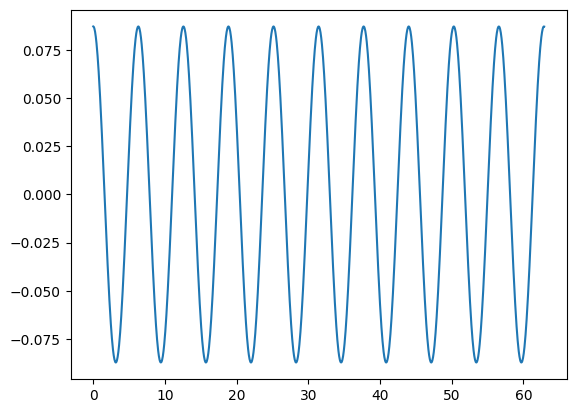In-class Example: The Pendulum#
In the last homework, you integrated a finite-amplitude pendulum and looked at the energy conservation properties. Now we’ll look at the FFT of the pendulum.
import numpy as np
import matplotlib.pyplot as plt
Here’s a simple class that creates a pendulum and can integrate it using fixed timesteps. It is important that our data be regularly spaced for the FFT.
class Pendulum:
""" a simple pendulum (w/o the small angle approximation).
Here, theta0 is in degrees"""
def __init__(self, theta0, g=9.81, L=9.81):
self.theta0 = np.radians(theta0)
self.g = g
self.L = L
self.t = None
self.theta = None
self.omega = None
def period(self):
""" return the period up to the theta**2 term """
return 2.0*np.pi*np.sqrt(self.L/self.g)*(1.0 + self.theta0**2/16.0)
def rhs(self, theta, omega):
""" equations of motion for a pendulum
dtheta/dt = omega
domega/dt = - (g/L) sin theta """
return np.array([omega, -(self.g/self.L)*np.sin(theta)])
def integrate(self, dt, tmax):
"""integrate the equations of motion using 4th-order
Runge-Kutta. Here, theta0 is the initial angle from vertical,
in radians.
Note: we use uniform steps here -- this is important to allow
for an FFT (which needs uniformly spaced samples).
"""
# initial conditions
t = 0.0
theta = self.theta0
omega = 0.0 # at the maximum angle, the angular velocity is 0
# store the history for plotting
t_s = [t]
theta_s = [theta]
omega_s = [omega]
while t < tmax:
# get the RHS at time-level n
thetadot1, omegadot1 = self.rhs(theta, omega)
thetadot2, omegadot2 = self.rhs(theta + 0.5*dt*thetadot1,
omega + 0.5*dt*omegadot1)
thetadot3, omegadot3 = self.rhs(theta + 0.5*dt*thetadot2,
omega + 0.5*dt*omegadot2)
thetadot4, omegadot4 = self.rhs(theta + dt*thetadot3,
omega + dt*omegadot3)
theta += (dt/6.0)*(thetadot1 + 2.0*thetadot2 +
2.0*thetadot3 + thetadot4)
omega += (dt/6.0)*(omegadot1 + 2.0*omegadot2 +
2.0*omegadot3 + omegadot4)
t += dt
# store
t_s.append(t)
theta_s.append(theta)
omega_s.append(omega)
self.t = np.asarray(t_s)
self.theta = np.asarray(theta_s)
self.omega = np.asarray(omega_s)
Let’s make a model. We’ll use the expansion of the period with \(\theta\) to estimate the period and try to integrate for an even number of periods.
p = Pendulum(5)
period = p.period()
tmax = 10 * period
p.integrate(0.05, tmax)
fig, ax = plt.subplots()
ax.plot(p.t, p.theta)
[<matplotlib.lines.Line2D at 0x7f2bf48cde90>]

Now let’s compute the FFT of this and see if we can identify the frequency. The frequency should be at
nu = 1.0 / p.period()
nu
np.float64(0.15907922699241395)
What happens to our FFT if we don’t integrate for exactly a multiple of the period? Then our time-series is not periodic. How does this manifest itself in the FFT?


